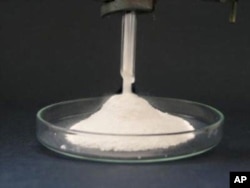Dry water made some waves at a recent American Chemical Society meeting in Boston. The substance looks a lot like fine white sand, which isn't surprising since what makes it dry is that each tiny water droplet is covered with water-repelling silica, the stuff of ordinary beach sand.
The coating makes it impossible for the water molecules to recombine and turn back into a liquid. And the fine powder that results can bond chemically with gases and form useful compounds called hydrates. And it's easy to make says University of Liverpool researcher Ben Carter, "by blending silicon and water together at high speeds."
Dry water is nothing new. Patented in 1968, it captured interest early on for its potential in the cosmetics industry. But in recent years Carter and his colleagues have focused on some important new uses for dry water's unique properties, beginning with its ability to bond with methane. They're hopeful that might someday provide a safer way to store methane fuel in natural gas-powered vehicles.
"Methane hydrate was our particular target, as the improved storage and transport of methane as natural gas is a key part of its development as a greener alternative to other fossil fuels," Carter says. "We've gone on to show that the same can be done with CO2, forming a CO2 hydrate, which will store three times as much CO2 in the same time using dry water as you would with bulk water."
Carter says that, because it can absorb such large amounts of carbon dioxide, the dry-water hydrate could prove to be an effective method for reducing climate-changing gases in the atmosphere. Carter says other lab experiments indicate that dry water could be made more recyclable by adding a gelling agent to the water before it is blended. "And this dry gel is more robust and capable of going through multiple cycles of gas uptake and release."
The chemists also see environmental benefits in dry water's use in the manufacture of drugs, foods ingredients and other consumer products.
Lab tests suggest it could greatly speed up the catalytic reactions involved in making these goods, and permit greener, more energy-efficient chemical processing. They also believe the dry water technology shows promise as a way of safely storing and shipping potentially harmful liquids, by transforming them into a dry, stable powder.
Carter and colleagues discussed these and other applications for dry water at a recent meeting of the American Chemical Society in Boston.









